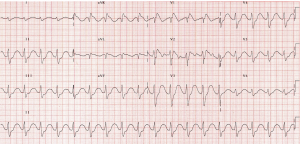- The terminal R in AVR can be seen with any significant ingestion of a sodium channel blocking agent (including TCAs).
- Sodium channel blocking agents work by delaying phase 0 (upward stroke) of the myocardial action potential. This leads to changes in QRS morphology and duration.
- The right-sided intraventricular conduction system is more vulnerable to toxic effects of some sodium channel blockers compared to the left bundle. Delayed depolarization of RV thus preferentially affects QRS of aVR, leading to prominent R wave and rightward terminal axis deviation, as well as potential RBBB.
- Sodium channel blockade also causes the typical widening of the QRS due to delayed depolarization.
Yates C, Manini A. Utility of the Electrocardiogram in Drug Overdose and Poisoning: Theoretical Considerations and Clinical Implications. Current Cardiology Reviews 2012; 8: 137-151.

